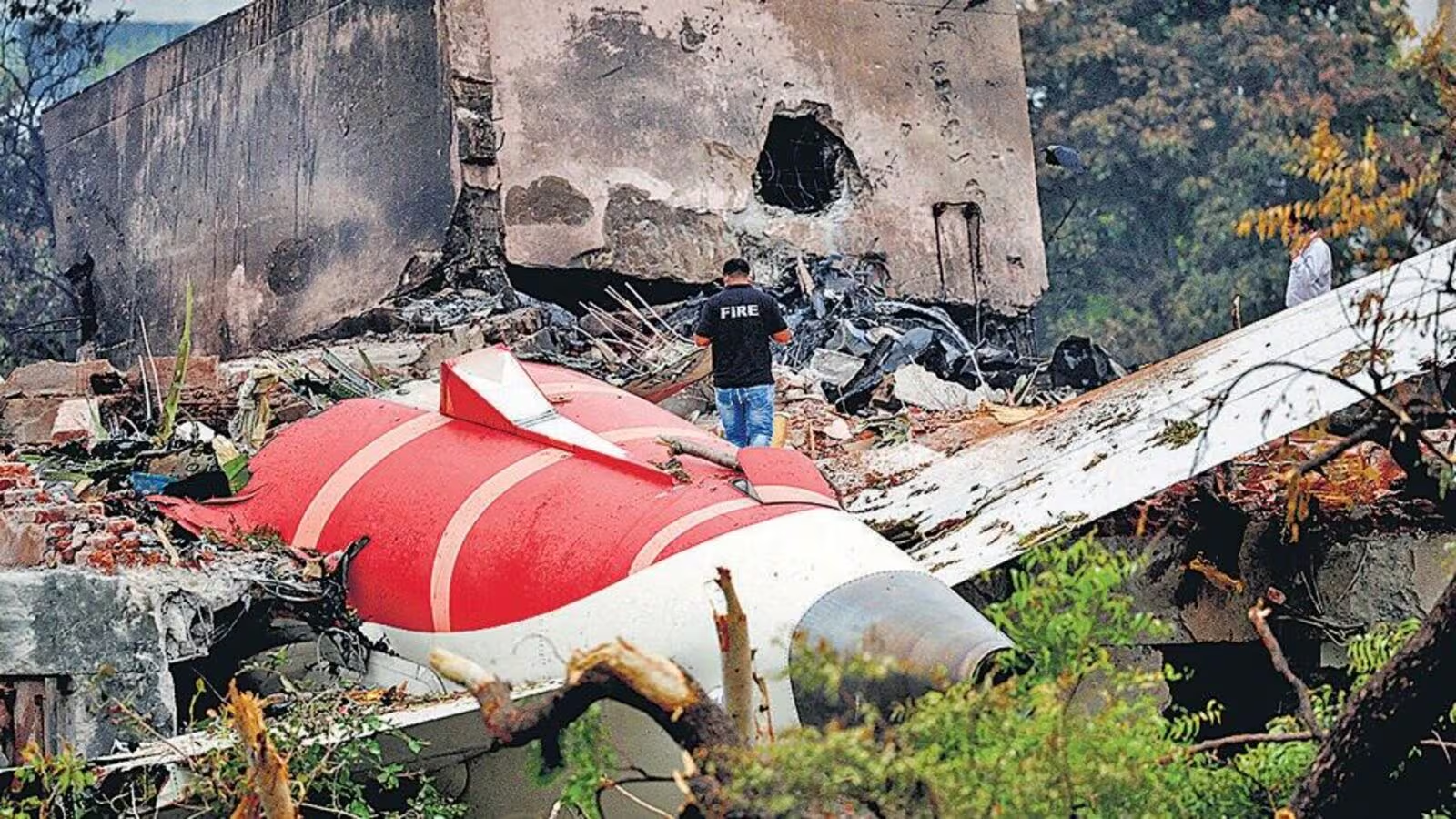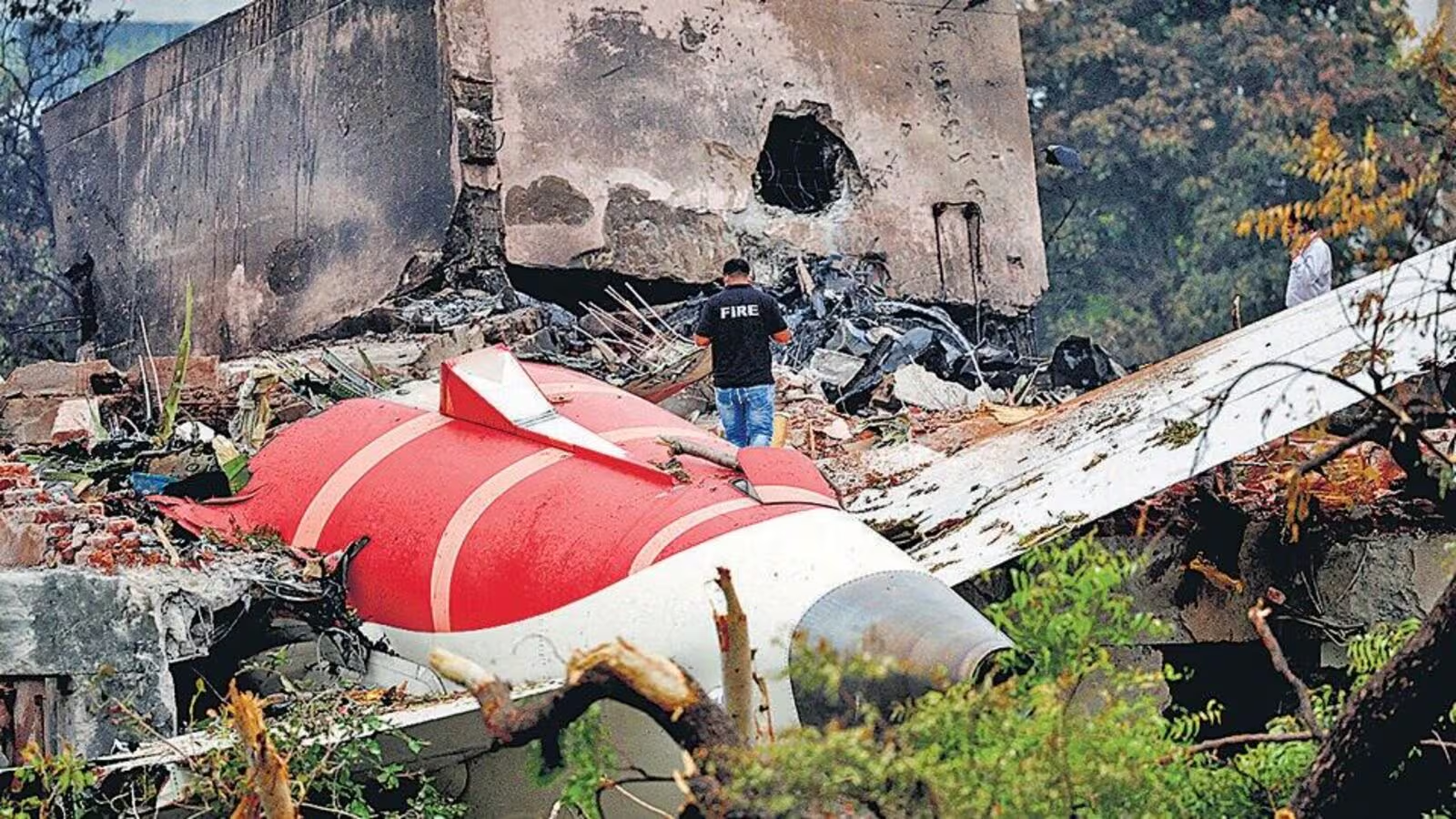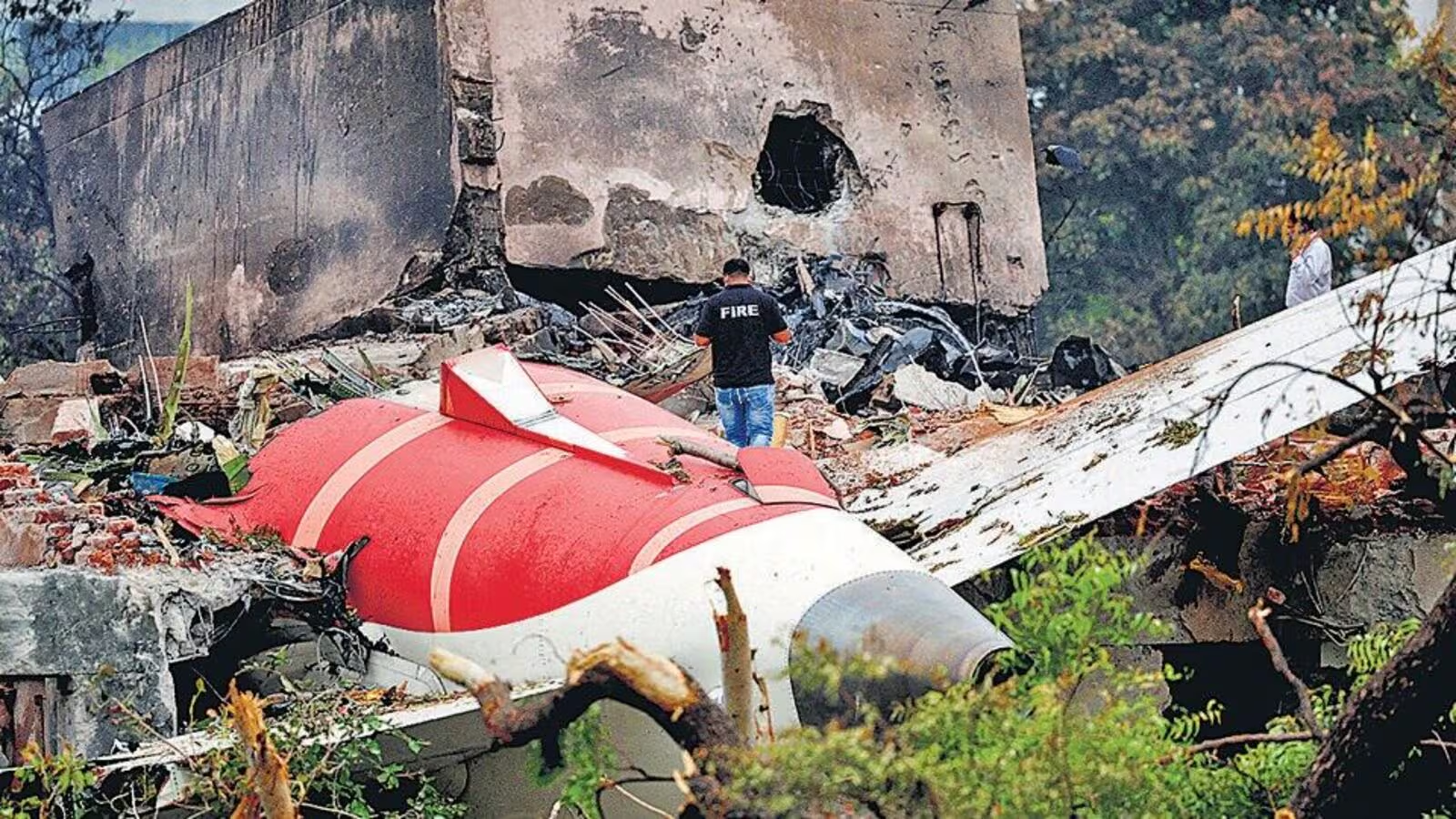A Devastating Event: Air India Ahmedabad Crash
- Preliminary Report Details Tragic Air India Ahmedabad Crash: A preliminary report has been released regarding the accident involving Air India’s B787-8 aircraft, registration VT-ANB, which crashed in Ahmedabad on June 12, 2025. The investigation, conducted by the Aircraft Accident Investigation Bureau (AAIB) under the Ministry of Civil Aviation, Government of India, aims solely at accident prevention and not at apportioning blame or liability.
- Flight AI171’s Ill-Fated Takeoff: The aircraft, operating as Flight AI171 from Ahmedabad to London Gatwick, crashed around 08:09 UTC (13:39 IST) immediately after takeoff from Sardar Vallabhbhai Patel International Airport (VAAH). The accident site was identified at coordinates 23∘03′17.8′′N 72∘36′43.6′′E in Ahmedabad.
- Fatalities and Injuries in the Air India Ahmedabad Crash: The accident resulted in a significant loss of life.
- Crew Fatalities: All 12 crew members on board perished.
- Passenger Casualties: 229 passengers suffered fatal injuries, with one passenger sustaining serious injuries.
- Ground Fatalities: 19 individuals on the ground were killed, and 67 sustained minor or no injuries.
- International Concerns: The fatalities among passengers included citizens from the United Kingdom, Portugal, and Canada, prompting notification to the respective accident investigation authorities in those countries.
Investigation Underway for Air India Ahmedabad Crash
- Prompt Response and International Collaboration: The AAIB was notified of the accident on June 12, 2025, and a team of five officers, including the Director General, immediately deployed to Ahmedabad. Three officers from DGCA’s Air Safety Directorate also arrived to assist. The initial notification, as per ICAO Annex 13, was sent to the National Transportation Safety Board (NTSB), USA, as the State of Design and Manufacture. The NTSB appointed an Accredited Representative and Technical Advisers from Boeing, GE, and the Federal Aviation Administration (FAA), who arrived on June 15, 2025, to participate in the investigation. A team from the AAIB-UK also visited the site.
- Investigation Team and Subject Matter Experts: The DG-AAIB appointed an investigation team led by Mr. Sanjay Kumar Singh as Investigator-in-Charge. Experienced pilots, engineers, aviation medicine specialists, aviation psychologists, and flight recorder specialists were brought in as Subject Matter Experts (SMEs) to assist.
Aircraft Information Pertinent to Air India Ahmedabad Crash
- Aircraft Details: The involved aircraft was a Boeing 787-8, bearing serial number 36279, manufactured in 2013. It was owned and operated by Air India.
- Maintenance Status: The aircraft had accumulated 41,868 total hours of flight.
- The last major line maintenance check (L1-1 and L1-2) was performed at 38,504:12 hours and 7255 cycles.
- The next major check (D Check) was due in December 2025.
- Both engines had been recently installed: the Left Hand (LH) engine on May 1, 2025, and the Right Hand (RH) engine on March 26, 2025.
- Active MEL Items: On the day of the accident, June 12, 2025, there were four Category ‘C’ Minimum Equipment List (MEL) items active, valid until June 19, 2025, related to the flight deck door visual surveillance, airport map function, core network, and FD printer. A Category A MEL regarding nitrogen generation performance was also active, valid until June 20, 2025. Other Category D MELs/NEFs related to cabin and cargo were also within their validity dates.
- Airworthiness Directives and Service Bulletins: All applicable Airworthiness Directives and Alert Service Bulletins had been complied with for both the aircraft and its engines.
- Fuel Control Switch Advisory: A Special Airworthiness Information Bulletin (SAIB) No. NM-18-33 was issued by the FAA on December 17, 2018, concerning the potential disengagement of the fuel control switch locking feature, citing similar designs across various Boeing models, including the B787-8 (VT-ANB). Air India had not carried out the suggested inspections as the SAIB was advisory, not mandatory. Maintenance records showed throttle control module replacements in 2019 and 2023, but these were not linked to the fuel control switch. No defects related to the fuel control switch had been reported on VT-ANB since 2023.
Damages and Wreckage Distribution from Air India Ahmedabad Crash
- Aircraft Destruction and Ground Impact: The aircraft was destroyed upon impact with buildings on the ground and subsequent fire. Five buildings, primarily the BJ Medical College hostel located 0.9 NM from the departure end of Runway 23, suffered major structural and fire damage.
- Wreckage Field: The wreckage was spread over an area of approximately 1000 ft×400 ft, extending from the first impact point (a series of trees and an incineration chimney) to the last identified aircraft item.
- Impact Sequence and Component Locations:
- The initial impact was with a series of trees and an incineration chimney within the Army Medical Corps compound, before impacting the northeast wall of Building A.
- The distance between the initial tree contact and the impact point on Building A was 293 ft.
- The aircraft impacted Building A with a likely nose-up attitude of about 8 degrees and wings level.
- The vertical stabilizer separated and came to rest about 200 feet south of Building A’s initial contact point.
- The tail section and RH Main Landing Gear (MLG) were embedded in Building A, while the rest of the aircraft continued forward.
- The right engine struck a concrete water tank structure on the roof of Building A, separated, and came to rest underneath it.
- Inboard parts of the right wing were found in Buildings A and B, with the mid-section and outboard section found 280 feet and 520 feet southwest, respectively, from Building A’s initial impact.
- The left main landing gear (LH MLG) and left wing outboard and middle sections struck Building C, coming to rest approximately 345 feet south of the initial impact.
- The left engine separated and struck the north corner of Building D at ground level, causing significant damage to the wall and column.
- The nose landing gear (NLG) was found about 307 feet southwest from the initial impact with Building A.
- The fuselage fragmented and sustained thermal damage, with the furthest debris observed about 765 feet southwest from Building A’s initial impact.
- The flight deck area and windshield support structure came to rest approximately 650 feet southwest from Building A’s initial impact.
- The APU air inlet door was found open, consistent with APU auto-start logic.
- The flap handle assembly was found firmly in the 5-degree flap position, consistent with a normal takeoff setting, a finding confirmed by EAFR data.
- The landing gear lever was in the “DOWN” position.
- Both thrust levers were found near the aft (idle) position, although EAFR data indicated they remained at takeoff thrust until impact.
- Both fuel control switches were found in the “RUN” position. The reverser levers were bent but in the “stowed” position.
Personnel and Meteorological Data for Air India Ahmedabad Crash
- Flight Crew Information:
- Pilot-in-Command (PIC): 56-year-old male, ATPL holder with 15,638:22 total flying hours, including 8,596:43 hours on type (B787) and 8,260:43 hours as PIC on type. His medical examination was valid until May 14, 2026.
- Co-Pilot: 32-year-old male, CPL holder with 3,403:12 total flying hours, including 1,128:14 hours on type (B787) as co-pilot. His medical examination was valid until September 26, 2025.
- Both pilots had adequate rest prior to the flight and passed pre-flight Breath Analyzer tests. The co-pilot was the Pilot Flying (PF), and the PIC was the Pilot Monitoring (PM).
- Meteorological Conditions: Weather at SVPI Airport, Ahmedabad, at the time of the accident (08:09 UTC) showed wind from 250∘ at 07 Kts, visibility of 6000m, no significant weather (NSC), temperature of 37∘C, and QNH of 1001 hPa.
Aerodrome and Communications Leading to Air India Ahmedabad Crash
- Airport Details: Sardar Vallabhbhai Patel International Airport, Ahmedabad, is a DGCA licensed airport with a license valid until September 9, 2028. Runway 05-23 is 3505m long and 45m wide with an asphalt surface.
- ATC Communications Timeline:
- 07:43:00 UTC: Aircraft requested pushback and startup.
- 07:43:13 UTC: ATC approved pushback.
- 07:46:59 UTC: ATC approved startup.
- 07:49:12 UTC: ATC queried full runway length; aircraft confirmed requirement for full length of Runway 23.
- 07:55:15 UTC: Aircraft requested and received taxi clearance.
- 08:02:03 UTC: Aircraft transferred from Ground to Tower Control.
- 08:03:45 UTC: Aircraft instructed to line up on Runway 23.
- 08:07:33 UTC: Aircraft cleared for takeoff from Runway 23.
- 08:09:05 UTC: MAYDAY call was made by AI171.
Flight Recorders and Accident Flight Sequence in Air India Ahmedabad Crash
- Enhanced Airborne Flight Recorders (EAFRs): The aircraft was equipped with two EAFRs.
- The aft EAFR was found on the roof of Building A with impact and thermal damage. It could not be downloaded conventionally due to extensive damage.
- The forward EAFR was found near Building F, burnt and covered in soot. It contained a Recorder Independent Power Supply (RIPS) for continued recording after power loss.
- Both EAFRs were transported to AAIB’s facility in New Delhi. Data from the forward EAFR was successfully downloaded with assistance from the NTSB, yielding approximately 49 hours of flight data (including the event flight) and two hours of cockpit voice recording.
- Pre-Flight Status: The aircraft arrived in Ahmedabad from Delhi as flight AI423. A “STAB POS XDCR” status message was reported by the previous crew, which was troubleshooted and cleared by Air India maintenance personnel.
- Takeoff Sequence (Based on EAFR Data):
- 08:07:37 UTC: Aircraft started rolling for takeoff.
- 08:08:33 UTC: Aircraft crossed take-off decision speed (V1) and achieved 153 kts IAS.
- 08:08:35 UTC: Vr speed (155 kts) achieved.
- 08:08:39 UTC: Aircraft transitioned to air mode, consistent with liftoff.
- 08:08:42 UTC: Aircraft achieved maximum recorded airspeed of 180 Knots IAS.
- Immediately thereafter, Engine 1 and Engine 2 fuel cutoff switches transitioned from RUN to CUTOFF with a 1-second gap, causing engine N1 and N2 to decrease.
- In the cockpit voice recording, one pilot questioned the cutoff, and the other denied initiating it.
- 08:08:47 UTC: Ram Air Turbine (RAT) deployed during the initial climb immediately after liftoff, and its hydraulic pump began supplying hydraulic power.
- 08:08:52 UTC: Engine 1 fuel cutoff switch transitioned from CUTOFF to RUN.
- 08:08:54 UTC: APU Inlet Door began opening, consistent with APU Auto Start logic.
- 08:08:56 UTC: Engine 2 fuel cutoff switch transitioned from CUTOFF to RUN.
- Both engines showed rising EGT, indicating relight. Engine 1’s core deceleration stopped and reversed, starting recovery. Engine 2 relit but could not arrest core speed deceleration and repeatedly re-introduced fuel for recovery.
- 08:09:05 UTC: MAYDAY call transmitted.
- 08:09:11 UTC: EAFR recording stopped.
- 08:14:44 UTC: Crash Fire Tender left airport premises for rescue and firefighting.
Ongoing Progress of Air India Ahmedabad Crash Investigation
- Wreckage and Component Management: Wreckage site activities are complete, and the wreckage has been moved to a secure area. Both engines were retrieved and quarantined. Components of interest for further examination have been identified and quarantined.
- Fuel Sample Analysis: Fuel samples from the bowsers and tanks used to refuel the aircraft were tested at DGCA’s Lab and found satisfactory. Limited fuel samples from the APU filter and left wing’s Refuel/Jettison valve are awaiting specialized testing.
- Data Analysis and Witness Statements: Detailed analysis of the downloaded forward EAFR data is ongoing. Statements from witnesses and surviving passengers have been collected. Postmortem reports of the crew and passengers are being analyzed to correlate aeromedical findings with engineering appreciation.
- No Immediate Actions Recommended: At this preliminary stage, no recommended actions have been issued to B787-8 and/or GE GEnx-1B engine operators and manufacturers.
- Continued Investigation: The investigation is ongoing, and the team will continue to review and examine additional evidence, records, and information from stakeholders.
This tragic Air India Ahmedabad Crash serves as a somber reminder of the complexities inherent in aviation. The ongoing investigation aims to thoroughly understand the circumstances that led to this devastating event, with the ultimate goal of preventing future occurrences.
Discover more from RastriyaSamachar24x7
Subscribe to get the latest posts sent to your email.




